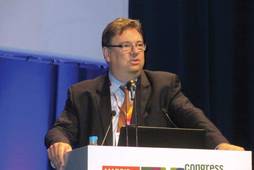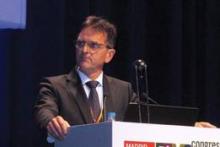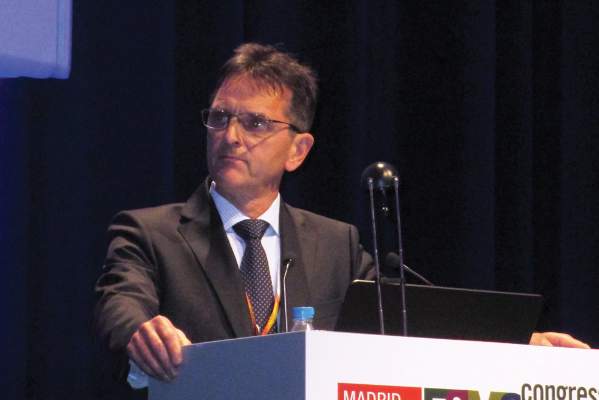User login
MADRID – A dose-dense, third-generation chemotherapy regimen surpassed a more standard regimen for adjuvant therapy of high-risk breast cancer patients with positive nodes and either triple-negative tumors or aggressive, luminal B phenotypes in an analysis of about 1,600 patients treated in two German phase III trials.
Adding these results to those from two prior phase III studies with similar findings firmly establishes the intensified, dose-dense approach as the preferred way to deliver third-generation chemotherapy to patients with these breast-cancer presentations, Dr. Christoph Thomssen reported at the annual congress of the European Society for Medical Oncology.
“We suggest adding iddETC [intense dose-dense epirubicin, paclitaxel, cyclophosphamide] to the group of preferred regimens in current guidelines,” said Dr. Thomssen, professor and director of gynecology at the University Clinic in Halle, Germany. Dr. Thomssen noted that some existing guidelines for breast cancer chemotherapy, such as from the National Comprehensive Cancer Network, already recommend dose-dense adjuvant therapy for breast cancer patients with positive lymph nodes and either triple-negative disease or the luminal B phenotype,
But in other countries, such as in Spain, France, and Italy, adoption of a dose-dense approach has not caught on, said Dr. Antonio Llombart-Cussac, head of medical oncology at Arnau de Vilanova Hospital in Valencia, Spain. For example, fewer than 5% of women with breast cancer who fit one of these high-risk profiles and receive treatment at a Spanish hospital currently get a dose-dense regimen, he said in an interview. The new evidence reported by Dr. Thomssen as well as results from an Italian study reported last year should together help change the practice of physicians who have not yet adopted the dose-dense approach, Dr. Llombart said.
The first German study, known as AGO ETC compared a standard schedule for administering epirubicin, cyclophosphamide, and paclitaxel sequentially at 3-week intervals with an accelerated schedule in which patients received dosages every 2 weeks: three sequential doses of 150 mg epirubicin/m2 every 2 weeks, followed by three sequential doses of 225 mg/m2 paclitaxel every 2 weeks, and finally three sequential dosages of 2.5 g/m2 cyclophosphamide every 2 weeks. The study randomized 1,284 patients with at least four positive lymph nodes during 1998-2003. During an average 5-year follow-up, the rate of event-free survival was 70% among patients on the dose-dense regimen and 62% among those on the standard regimen (P less than .001), a 0.72 hazard ratio (95% confidence interval 0.59-0.87), Dr. Thomssen reported.
The second trial he presented, known as GAIN (German Adjuvant Intergroup Node-Positive study), randomized 3,023 patients to either the same dose-dense regimen tested in the first study (but with 2.0 g/m2 cyclophosphamide), or to a second, different dose-dense regimen that also included capecitabine. Five-year results in this second trial showed a virtually identical, 80% event-free survival rate in each of the two treatment arms.
Dr. Thomssen highlighted the similarity of this 80% rate seen in 1,498 patients who received a dose-dense regimen that was very similar to the one used in the first study with the 70% event-free survival rate seen in the dose-dense arm of the first study. He concluded that these results from the GAIN trial validated the results from the first trial. Among patients in GAIN with at least four positive lymph nodes, who most closely matched the patients enrolled in the first trial, the 5-year event-free survival rate was 75%.
Additional subgroup analyses of results from the first trial showed that the added benefit from the dose-dense regimen occurred consistently across all patient subgroups. The dose-dense regimen was also well tolerated, producing about a 7% rate of febrile neutropenia, and a cardiac failure rate of less than 1%. The most common adverse event was peripheral neuropathy, which occurred in 25%-55% of treated patients.
On Twitter @mitchelzoler
The results from these two German trials confirm that dose-dense chemotherapy regimens are extremely effective for adjuvant treatment of women with high-risk, node-positive early breast cancer of either the triple-negative type or with the luminal B phenotype.
U.S. researchers first reported similar findings in results published more than 10 years ago (J. Clin. Onc. 2003;21:1431-9), although concerns existed about the relevance of the treatment received by control patients in that study. Last year, Dr. Cognetti and other Italian researchers reported a significant benefit from a dose-dense regimen in a controlled study, but those results remain unpublished as of now. Further confirmation by these two German studies now clearly establishes dose-dense regimens as the standard of care for adjuvant treatment of these types of breast cancer patients. The intensified, dose-dense method is the preferred way to administer anthracyclines and taxanes for adjuvant treatment in these high-risk patients.

|
Dr. Antonio Llombart-Cussac |
In some countries, such as in the United States and Germany, dose-dense regimens are already standard, but not in other European countries including Spain, Italy, and France. One reason is that the dose-dense method costs more, as patients more often need support by treatment with granulocyte colony stimulating factor, an agent that can increase treatment costs three-fold. Some clinicians have also had lingering concern about the potential of the dose-dense method to boost episodes of secondary leukemia, So far, follow-up has shown no indication of increased hematologic malignancies in the German or Italian patients, but follow-up in these three trials has been brief, relative to the 10-20 years it could take for this adverse effect to appear. However, the immediate efficacy benefit from dose-dense treatment is important enough to justify using this approach even if we eventually see a small increased rate of late leukemias.
Dr. Antonio Llombart-Cussac is head of medical oncology at Arnau de Vilanova Hospital in Valencia, Spain. He has received honoraria as a speaker for or adviser to Celgene, GlaxoSmithKline, Roche, AstraZeneca, Novartis, and Lilly. He made these comments as a designated discussant for the reports and in an interview.
The results from these two German trials confirm that dose-dense chemotherapy regimens are extremely effective for adjuvant treatment of women with high-risk, node-positive early breast cancer of either the triple-negative type or with the luminal B phenotype.
U.S. researchers first reported similar findings in results published more than 10 years ago (J. Clin. Onc. 2003;21:1431-9), although concerns existed about the relevance of the treatment received by control patients in that study. Last year, Dr. Cognetti and other Italian researchers reported a significant benefit from a dose-dense regimen in a controlled study, but those results remain unpublished as of now. Further confirmation by these two German studies now clearly establishes dose-dense regimens as the standard of care for adjuvant treatment of these types of breast cancer patients. The intensified, dose-dense method is the preferred way to administer anthracyclines and taxanes for adjuvant treatment in these high-risk patients.

|
Dr. Antonio Llombart-Cussac |
In some countries, such as in the United States and Germany, dose-dense regimens are already standard, but not in other European countries including Spain, Italy, and France. One reason is that the dose-dense method costs more, as patients more often need support by treatment with granulocyte colony stimulating factor, an agent that can increase treatment costs three-fold. Some clinicians have also had lingering concern about the potential of the dose-dense method to boost episodes of secondary leukemia, So far, follow-up has shown no indication of increased hematologic malignancies in the German or Italian patients, but follow-up in these three trials has been brief, relative to the 10-20 years it could take for this adverse effect to appear. However, the immediate efficacy benefit from dose-dense treatment is important enough to justify using this approach even if we eventually see a small increased rate of late leukemias.
Dr. Antonio Llombart-Cussac is head of medical oncology at Arnau de Vilanova Hospital in Valencia, Spain. He has received honoraria as a speaker for or adviser to Celgene, GlaxoSmithKline, Roche, AstraZeneca, Novartis, and Lilly. He made these comments as a designated discussant for the reports and in an interview.
The results from these two German trials confirm that dose-dense chemotherapy regimens are extremely effective for adjuvant treatment of women with high-risk, node-positive early breast cancer of either the triple-negative type or with the luminal B phenotype.
U.S. researchers first reported similar findings in results published more than 10 years ago (J. Clin. Onc. 2003;21:1431-9), although concerns existed about the relevance of the treatment received by control patients in that study. Last year, Dr. Cognetti and other Italian researchers reported a significant benefit from a dose-dense regimen in a controlled study, but those results remain unpublished as of now. Further confirmation by these two German studies now clearly establishes dose-dense regimens as the standard of care for adjuvant treatment of these types of breast cancer patients. The intensified, dose-dense method is the preferred way to administer anthracyclines and taxanes for adjuvant treatment in these high-risk patients.

|
Dr. Antonio Llombart-Cussac |
In some countries, such as in the United States and Germany, dose-dense regimens are already standard, but not in other European countries including Spain, Italy, and France. One reason is that the dose-dense method costs more, as patients more often need support by treatment with granulocyte colony stimulating factor, an agent that can increase treatment costs three-fold. Some clinicians have also had lingering concern about the potential of the dose-dense method to boost episodes of secondary leukemia, So far, follow-up has shown no indication of increased hematologic malignancies in the German or Italian patients, but follow-up in these three trials has been brief, relative to the 10-20 years it could take for this adverse effect to appear. However, the immediate efficacy benefit from dose-dense treatment is important enough to justify using this approach even if we eventually see a small increased rate of late leukemias.
Dr. Antonio Llombart-Cussac is head of medical oncology at Arnau de Vilanova Hospital in Valencia, Spain. He has received honoraria as a speaker for or adviser to Celgene, GlaxoSmithKline, Roche, AstraZeneca, Novartis, and Lilly. He made these comments as a designated discussant for the reports and in an interview.
MADRID – A dose-dense, third-generation chemotherapy regimen surpassed a more standard regimen for adjuvant therapy of high-risk breast cancer patients with positive nodes and either triple-negative tumors or aggressive, luminal B phenotypes in an analysis of about 1,600 patients treated in two German phase III trials.
Adding these results to those from two prior phase III studies with similar findings firmly establishes the intensified, dose-dense approach as the preferred way to deliver third-generation chemotherapy to patients with these breast-cancer presentations, Dr. Christoph Thomssen reported at the annual congress of the European Society for Medical Oncology.
“We suggest adding iddETC [intense dose-dense epirubicin, paclitaxel, cyclophosphamide] to the group of preferred regimens in current guidelines,” said Dr. Thomssen, professor and director of gynecology at the University Clinic in Halle, Germany. Dr. Thomssen noted that some existing guidelines for breast cancer chemotherapy, such as from the National Comprehensive Cancer Network, already recommend dose-dense adjuvant therapy for breast cancer patients with positive lymph nodes and either triple-negative disease or the luminal B phenotype,
But in other countries, such as in Spain, France, and Italy, adoption of a dose-dense approach has not caught on, said Dr. Antonio Llombart-Cussac, head of medical oncology at Arnau de Vilanova Hospital in Valencia, Spain. For example, fewer than 5% of women with breast cancer who fit one of these high-risk profiles and receive treatment at a Spanish hospital currently get a dose-dense regimen, he said in an interview. The new evidence reported by Dr. Thomssen as well as results from an Italian study reported last year should together help change the practice of physicians who have not yet adopted the dose-dense approach, Dr. Llombart said.
The first German study, known as AGO ETC compared a standard schedule for administering epirubicin, cyclophosphamide, and paclitaxel sequentially at 3-week intervals with an accelerated schedule in which patients received dosages every 2 weeks: three sequential doses of 150 mg epirubicin/m2 every 2 weeks, followed by three sequential doses of 225 mg/m2 paclitaxel every 2 weeks, and finally three sequential dosages of 2.5 g/m2 cyclophosphamide every 2 weeks. The study randomized 1,284 patients with at least four positive lymph nodes during 1998-2003. During an average 5-year follow-up, the rate of event-free survival was 70% among patients on the dose-dense regimen and 62% among those on the standard regimen (P less than .001), a 0.72 hazard ratio (95% confidence interval 0.59-0.87), Dr. Thomssen reported.
The second trial he presented, known as GAIN (German Adjuvant Intergroup Node-Positive study), randomized 3,023 patients to either the same dose-dense regimen tested in the first study (but with 2.0 g/m2 cyclophosphamide), or to a second, different dose-dense regimen that also included capecitabine. Five-year results in this second trial showed a virtually identical, 80% event-free survival rate in each of the two treatment arms.
Dr. Thomssen highlighted the similarity of this 80% rate seen in 1,498 patients who received a dose-dense regimen that was very similar to the one used in the first study with the 70% event-free survival rate seen in the dose-dense arm of the first study. He concluded that these results from the GAIN trial validated the results from the first trial. Among patients in GAIN with at least four positive lymph nodes, who most closely matched the patients enrolled in the first trial, the 5-year event-free survival rate was 75%.
Additional subgroup analyses of results from the first trial showed that the added benefit from the dose-dense regimen occurred consistently across all patient subgroups. The dose-dense regimen was also well tolerated, producing about a 7% rate of febrile neutropenia, and a cardiac failure rate of less than 1%. The most common adverse event was peripheral neuropathy, which occurred in 25%-55% of treated patients.
On Twitter @mitchelzoler
MADRID – A dose-dense, third-generation chemotherapy regimen surpassed a more standard regimen for adjuvant therapy of high-risk breast cancer patients with positive nodes and either triple-negative tumors or aggressive, luminal B phenotypes in an analysis of about 1,600 patients treated in two German phase III trials.
Adding these results to those from two prior phase III studies with similar findings firmly establishes the intensified, dose-dense approach as the preferred way to deliver third-generation chemotherapy to patients with these breast-cancer presentations, Dr. Christoph Thomssen reported at the annual congress of the European Society for Medical Oncology.
“We suggest adding iddETC [intense dose-dense epirubicin, paclitaxel, cyclophosphamide] to the group of preferred regimens in current guidelines,” said Dr. Thomssen, professor and director of gynecology at the University Clinic in Halle, Germany. Dr. Thomssen noted that some existing guidelines for breast cancer chemotherapy, such as from the National Comprehensive Cancer Network, already recommend dose-dense adjuvant therapy for breast cancer patients with positive lymph nodes and either triple-negative disease or the luminal B phenotype,
But in other countries, such as in Spain, France, and Italy, adoption of a dose-dense approach has not caught on, said Dr. Antonio Llombart-Cussac, head of medical oncology at Arnau de Vilanova Hospital in Valencia, Spain. For example, fewer than 5% of women with breast cancer who fit one of these high-risk profiles and receive treatment at a Spanish hospital currently get a dose-dense regimen, he said in an interview. The new evidence reported by Dr. Thomssen as well as results from an Italian study reported last year should together help change the practice of physicians who have not yet adopted the dose-dense approach, Dr. Llombart said.
The first German study, known as AGO ETC compared a standard schedule for administering epirubicin, cyclophosphamide, and paclitaxel sequentially at 3-week intervals with an accelerated schedule in which patients received dosages every 2 weeks: three sequential doses of 150 mg epirubicin/m2 every 2 weeks, followed by three sequential doses of 225 mg/m2 paclitaxel every 2 weeks, and finally three sequential dosages of 2.5 g/m2 cyclophosphamide every 2 weeks. The study randomized 1,284 patients with at least four positive lymph nodes during 1998-2003. During an average 5-year follow-up, the rate of event-free survival was 70% among patients on the dose-dense regimen and 62% among those on the standard regimen (P less than .001), a 0.72 hazard ratio (95% confidence interval 0.59-0.87), Dr. Thomssen reported.
The second trial he presented, known as GAIN (German Adjuvant Intergroup Node-Positive study), randomized 3,023 patients to either the same dose-dense regimen tested in the first study (but with 2.0 g/m2 cyclophosphamide), or to a second, different dose-dense regimen that also included capecitabine. Five-year results in this second trial showed a virtually identical, 80% event-free survival rate in each of the two treatment arms.
Dr. Thomssen highlighted the similarity of this 80% rate seen in 1,498 patients who received a dose-dense regimen that was very similar to the one used in the first study with the 70% event-free survival rate seen in the dose-dense arm of the first study. He concluded that these results from the GAIN trial validated the results from the first trial. Among patients in GAIN with at least four positive lymph nodes, who most closely matched the patients enrolled in the first trial, the 5-year event-free survival rate was 75%.
Additional subgroup analyses of results from the first trial showed that the added benefit from the dose-dense regimen occurred consistently across all patient subgroups. The dose-dense regimen was also well tolerated, producing about a 7% rate of febrile neutropenia, and a cardiac failure rate of less than 1%. The most common adverse event was peripheral neuropathy, which occurred in 25%-55% of treated patients.
On Twitter @mitchelzoler
AT ESMO 2014
Key clinical point: A dose-dense chemotherapy regimen surpassed conventional dosing in high-risk breast-cancer patients.
Major finding: A dose-dense regimen produced 70% 5-year event-free survival, compared with a 62% rate with standard treatment.
Data source: AGO ETC and GAIN, two multicenter, controlled phase III German trials with a total of 2,141 patients receiving the dose-dense regimen.
Disclosures: The two investigator-initiated trials received grant support from Amgen, Bristol-Myers Squibb, Janssen-Cilag, and Roche. Dr. Thomssen has received honoraria as a speaker for Amgen, Celgene, Pfizer, Roche, Sanofi-Aventis, and TEVA.

